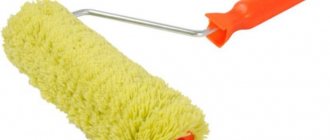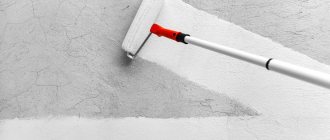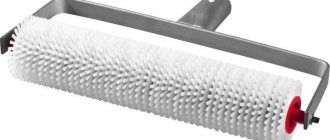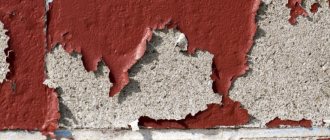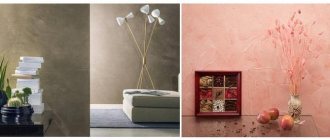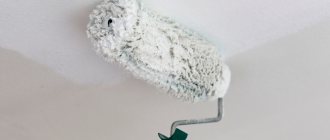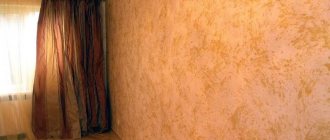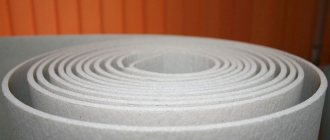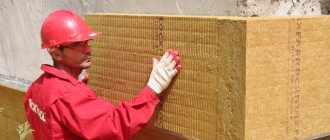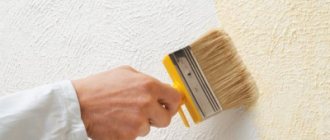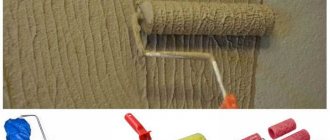Choosing the right roller for water-based paint is the key to quality repairs. Often insufficient attention is paid to this; many people believe that any tool can be used for the job, but this is a misconception. For each coloring composition, there are the most suitable devices that provide the desired result. A mistake in choosing can lead to everything having to be redone.
Buying a roller and tricks for using it
When choosing a tool, it is recommended to pay attention to the following factors:
- the pile must be firmly fixed to the drum;
- the handle should be comfortable;
- after squeezing the fur coat with your fingers, its structural layer should quickly recover;
- The seam should not be felt on the drum, otherwise after painting there will be marks in the form of stripes on the ceiling.
When choosing a tool, you need to take into account the fact that if it is not possible to use a stepladder, then it is better to purchase a roller with a long handle. For most drums, the handle size ranges from 15 to 50 cm. For ease of use, it is advisable to choose a tool with a handle from 30 to 50 cm in length. Some manufacturers produce tools that have the ability to change the length of the handle.
Roller for painting the ceiling.
The use of a roller when painting the ceiling yourself with acrylic or a water-based mixture is as follows:
- First, assess the condition of the surface. If there is old paint on the ceiling, it must be removed with a scraper or stripper. If it is whitewash, then a 3% vinegar solution is used to remove it. After this, the entire surface is washed with clean water and then wait for it to dry.
- After this, you need to prime the ceiling. If areas affected by fungi or mold appear on it, then the primer should contain an antiseptic.
After this, you need to prepare a large and small roller, a painting tray, a small plastic vessel, 2 brushes (narrow and wide), and a rag.
The paint is diluted to the desired consistency in accordance with the instructions, poured into a vessel and tray.
If there are skirting boards or sockets under the ceiling, then start painting from them. This is done with a narrow brush before starting the main work. Then dip the roller in paint and roll it onto the tray. The ceiling treatment begins from the corner, and then the entire surface is covered with the mixture. It is necessary to carefully remove paint deposits.
It is recommended to move the tool smoothly so that the solution does not splash. You need to paint in squares so that they slightly overlap each other.
After finishing the ceiling treatment, it is recommended to wait 4 hours for the first coat of paint to dry. After this, work continues, applying strokes perpendicular to the original direction.
The quality of the dye determines how many times it will need to be applied to the surface to be treated. Most often, 2-3 layers are enough to paint the ceiling, and the last one should run parallel to the light from the window opening.
You can select a roller yourself, taking into account all the listed requirements. To prevent the instrument from deteriorating after the first painting, it is recommended to place it in an appropriate solvent (water, etc.).
Nuances of choice
Due to the fact that painting with water-based composition is becoming increasingly popular, obtaining the desired result will depend on the tool.
When choosing a roller in a store, you need to pay attention to the following factors:
- Quality. Elements must be free of defects and well secured.
- Deformation level. When compressed, the fur coat must restore its shape, otherwise painting will be difficult.
- The seam. The pad should not have a pronounced, tangible joint.
- Nap coating. Hair should not fall out.
- Convenience. When working without attachments, the handle should provide a comfortable grip.
Taking into account simple factors will ensure that you purchase a reliable tool.
What kind of rollers are there?
Trying to sort all the rollers on sale into shelves is a gamble. The fact is that a variety of criteria can serve as a starting point for classification. Starting from the type of fur coat used and ending with the size of the drum. All this ultimately affects not only the speed of work, but also the immediate convenience of doing so. Let's try to systematize the accumulated experience and go through each of them sequentially.
Handle size
As a rule, in domestically produced rollers this figure ranges from 30-50 centimeters
.
Experts note that these dimensions allow you to confidently hold the roller in your hands and carry out uniform painting. If the task is to paint individual elements, and not the ceiling as a whole, then you can choose a roller with a smaller handle - 15 centimeters
. As a rule, the producers of such products are foreign companies.
An excellent option is a tool with interchangeable handles, one of which is short and the other, on the contrary, long. This roller can be successfully used to perform a number of completely different tasks.
Drum size
The standard drum size in modern rollers is from 20 to 40 centimeters
. Of course, you can always find options, both smaller and larger, but such tools cannot be called universal, since they are not very convenient for general painting and are more suitable for use in solving a local problem associated with painting visible decorative elements of the ceiling surface .
Drum design
The drum can be attached to the roller body on both one side and the other. In all respects, the first option is preferable, since it allows you to change the drum coat over time, making the tool suitable for solving other problems.
The double-sided design, alas, significantly limits your “user interface” and you will not be able to change the coat.
Fur coat type
- fur;
- foam;
- polyacrylic;
- polyamide.
The advantage of a fur coat is that it saves paint and distributes it evenly over the entire surface. The natural fibers used to make such fur coats have standard absorbency, but are easily wrung out during the dyeing process. Of course, the final ease of use is correlated with the length of the pile.
A longer pile allows you to absorb more paint and apply a much thicker and more thorough layer. It uses strong and thick thread. In rollers with short or medium pile, the thread is much thinner, and the surface of the ceiling after processing with a roller will be covered with a thin and uniform layer of paint.
Now compare the information received with what you want the ceiling surface to look like in the end - and make the right decision.
Foam rollers are best used when your goal is to create some texture or relief on the ceiling. They work well with oil paint, which has the most dense, high-quality structure.
As for polyacrylic and polyamide paint rollers, their main area of use is decorative work. To highlight some interesting detail on the ceiling, refresh the color mood, diversify a fragment - this is exactly the kind of roller that should be used to paint the ceiling if your goal lies in this plane.
Painting a wall with a roller
Wallpaper for painting does not lose its relevance, so you should choose a special version of the tool for it. Deciding which roller to paint the wallpaper for painting depends on the type of base and the type of paint used. The process consists of main stages:
- Preliminary preparation of tools and surfaces.
- Carrying out painting work.
- Completion of work.
- Tool processing.
Each stage is important to obtain the desired result.
Preparing for work
Before painting, it is important to prepare the surface. It is necessary to eliminate all defects on it: chips, cracks, unevenness
This can be done with sand-cement mortar and putty. If it is not possible to level the walls, they can be covered with plasterboard. It solves the problem of unevenness and insulates the structure of the building. To protect baseboards and trim, you need masking tape.
Before starting painting work, you should prepare everything necessary for effective work. In addition to the basic elements (paint and roller), you will need:
- handle extension;
- paint container;
- protective clothing, respirator and goggles.
All surfaces of furniture and other objects located in the room should be covered with protective film. If possible, care should be taken to ensure ventilation. It will remove toxic fumes resulting from the evaporation of chemicals.
Painting work
Work should begin by pouring the dye into the container. The paint should be diluted according to the manufacturer's instructions. Any experiments can negate all the efforts made: the paint may become too liquid or thick.
Then the roller is lowered into the working composition for impregnation. The tool is then rolled over a grooved tray to remove excess.
Visually, the entire surface should be divided into several zones. When processing large areas, it is advisable to roll the roller diagonally. This technology allows the composition to be evenly distributed by covering the first layer with a second layer. You need to roll it out so that the layer is thin. Professionals believe that it is better to make three thin layers than one thick one.
Do not linger in one place to avoid swelling of the paint and changing the surface texture from smooth to rough. If an area is skipped, it is better to wait until the surface dries. Only after this can you begin re-painting.
Application technology
The technology of painting with a roller differs from the methods of applying paint with brushes. Coloring should begin from the top, moving down. Painting begins from the window for a more uniform application.
The square-cluster coloring technique is considered optimal for beginners. These are kind of tricks to make a large canvas piece by piece. It involves dividing the entire surface into 1 meter sections (0.7 m if necessary). The squares are filled in gradually. Work can be done horizontally or vertically.
After the first coat, streaks (the borders of the squares) may be visible, but they will quickly disappear after applying a second coat of paint.
The saturation of the coating depends on the number of layers. Paints of different composition require individual application: acrylic and water-based paints should be applied in 3-4 layers with an interval of 12 hours, oil paints can be applied in 2-3 layers.
Therefore, before painting, you should study the instructions for using a particular composition.
End of work
The remaining paint after work is isolated from direct contact with air. The water-based emulsion may dry out in 2-3 days. Oil paints also do not tolerate such contacts and lose their properties, so they need to be placed in a jar with a tight-fitting lid. Do not add paint to a can of untouched paint. Such mixing will negatively affect its quality.
Masking tape must be removed from trims and baseboards. This must be done before the painted layer has completely dried so that there is no streak left. After the paint has completely dried, you can remove the film from the furniture and throw away the used cape.
You can install lamps, sockets and switches on the painted surface.
Types of paint rollers
Speaking about the types of rollers, it is worth understanding that their classification can be based on several parameters. It is possible to distinguish types of division of these instruments according to size, design and drum upholstery material used.
Separation of rollers by design
There are several design features on the basis of which paint rollers can be classified. Based on the type of cylinder mounting, they are divided into cantilever (the most common) and fork rollers. In the case of the former, the cylinder is attached on one side to a curved frame. In the case of fork rollers, the cylinder is fastened on both sides.
Based on the principle of the possibility of removing the ink surface (coat), rollers are distinguished on which its replacement is provided, and those where this possibility is not available. Also, based on the material of the body, one can distinguish between hard and elastic rollers. The elastic roller bracket is made of wire; this design is used to overcome differences in the surface being painted.
Separation of rollers by size
Roller for painting the ceiling
The size of the paint roller is one of the main parameters influencing the choice of a particular tool. There is the following gradation of paint roller sizes:
- Small-sized rollers. The width of their drum is within 15 centimeters, and the cross-sectional diameter of the cylinder does not exceed 1.5 centimeters. These will be convenient for painting hard-to-reach corners, including on ceilings where they intersect with a wall or if they have a non-uniform surface.
- Medium sized rollers. The cylinder width of this category of rollers varies between 15 and 25 centimeters, the cross-sectional diameter is from 5 to 9 centimeters. These roller sizes are considered universal; they are suitable for almost any surface and type of painting work. These rollers are used both by people who deal with painting work only in the case of renovations in their home, and by professional painters.
- Large-sized (facade) rollers. They have the following dimensions: cylinder width more than 25 centimeters, cross-sectional diameter from 8 centimeters. This category of rollers is common mainly among professionals and is used for painting external walls.
Thus, before purchasing a paint roller, you should first assess the scale of the painting work and, based on this data, make the final choice.
Separation of rollers according to drum upholstery material
The material of the coat, along with the size, is a fundamental criterion when choosing a roller for painting work. Modern rollers are distinguished by a wide variety of drum upholstery materials, including:
- Foam rubber. Due to its porous structure, this material allows it to absorb large amounts of paint at a time. This simplifies the process by reducing the number of roller wettings. True, working with foam rubber cladding requires certain skills, since with strong pressure from a tool on the surface to be painted, the foam rubber will release more paint than necessary.
- Synthetic rope fiber. Suitable for any paint and varnish materials, has good absorbency and excellent resistance to the destructive effects of paint. The length of the pile of such rollers varies from 0.8 to 2 centimeters.
- Artificial wool (polyacrylic). Roller coats made from this material also have good absorbency. In general, the characteristics of polyacrylic are similar to the previous material, but are less resistant to aggressive influences.
- Polyester. Rollers made using this material have excellent coloring ability, but they are short-lived. Polyester is fragile and prone to caking, so rollers that use it are the cheapest.
- Velours. Velor rollers are distinguished by good quality of painting on flat surfaces. This material is resistant to aggressive environments, so it can withstand soaking in a solvent without consequences. Velor absorbs little paint, which has a beneficial effect on the accuracy of painting work, but increases the labor intensity of the process.
- Natural fur. Most often, sheepskin is used for fur rollers. This tool does an excellent job of painting any surface with almost all types of paints. It is undesirable to use fur rollers only with paints that contain slaked lime.
The choice of roller covering material will usually be determined by conditions such as the texture of the surface to be painted and the type of paint used.
From foam rubber
The main advantage of using foam rollers for applying water-based paint is their low cost, as well as the ability to purchase them at any, even the smallest, repair store. One roller can be made from several types of foam rubber.
Pay attention to the percentage of high-density foam rubber, it is this that ensures resistance to mechanical stress.
However, foam rubber products have their disadvantages:
- the roller absorbs more paint than necessary, which is unprofitable from the point of view of rational use of materials;
- Due to excessive impregnation of foam rubber with water-based paint during work, a large number of bubbles may form on the surface and the coating will be uneven.
The main advantage of foam rollers is their low cost.
Varieties of such a tool as a roller
How to choose a roller for painting the ceiling? You need to start by assessing all the properties and qualities of existing types of tools. Rollers for painting the ceiling can be:
- Domestic production.
- Imported.
Many will not immediately understand the difference between them. The main difference between an imported roller and a domestic tool is that it is much smaller in size, but the coats for both are almost the same. There is a large selection of rollers at the moment, they can be classified by:
The photo shows examples of the tool.
Advice. Before deciding which roller you need to paint the ceiling, you need to choose a size that will be more convenient to work with. Not only the quality of painting, but also the speed of work completion depends on this.
- Everything is clear with the manufacturer. But the size of the handle can be varied. Its length starts at 30 cm and ends at 50 cm. These dimensions are more optimal for ease of use.
- As for the imported production of rollers, their handles can be 15 cm. Accordingly, the drum itself will be smaller. This type of tool is not used for large-scale ceiling painting. They carry out painting work on decorative interior elements.
- The size of the drum on the roller also differs. it can be from 20 cm to 40 cm. These are the standard tool sizes that are most often used in repair work. Sometimes you can find a larger size, but using such a roller yourself is not very convenient.
- What kind of roller is needed to paint the ceiling? Paint with its help should not only lie well on the surface, but also be evenly distributed on it.
Properties and advantages of rollers:
- Uniform distribution of paint composition on the surface. If you choose the right type of tool, then there will be no problems with such work.
- Good absorbency. The roller should absorb the paint so that excess can be easily removed using a special container.
- Practicality - using this type of tool is much easier and more convenient than a simple paint brush.
- Increasing the speed of painting work, since the roller drum is able to capture more of the surface than when using a brush.
Along with numerous advantages, there are also disadvantages of such a tool:
- If the roller handle is made of plastic, then it will not be able to withstand a lot of pressure.
- Some manufacturers' fixing of the drum is not very high-quality and in the process of painting the surface you can be left without a tool in your hands.
- It is not possible to paint hard-to-reach areas on the ceiling surface. These are coals and ceiling plinths. since the roller can only be used on a flat surface.
- In some cases, the price of such a tool is slightly overpriced. But, again, it all depends on the name of the manufacturer and its market reputation. There are rollers that are cheap, but their quality does not suffer from this.
- The drum on the roller can be fixed on one side or on both. The one-sided fastening makes the instrument universal, as it makes it possible to change the quality of the drum coat and its size.
- If the drum is fixed on both sides, then the roller can be used with only one type of fur coat.
- The main advantage of all painting tools is that they can be easily cleaned after completing a series of surface painting jobs.
Advice. To clean the roller from paint or any other product, it will be enough to place it in a container of water, in the case of using water-based paint, or in a solvent, in the case of using other types of coloring agents.
It is worth considering that a roller with any quality of coat should not be in a dirty state for a long time. This will deteriorate the structure of its coat and there is even the possibility of not using the roller in the future. Sometimes it only takes 30 minutes for a tool to become unusable.
A separate option for painting: textured rollers
To obtain an unusual surface, special rollers with texture are used. The granular base is created by using a fur device and applying a special textured paint. Patterns can be applied using roller stencils.
To obtain an unusual surface, special rollers with texture are used.
Which one is better to choose?
The choice is made based on the task at hand. Some rollers help you easily apply a pattern, while others help you create a three-dimensional design. Do not forget to take into account the type of enamels; some materials cannot withstand the solvents included in the composition, for example, the latex component.
Some rollers help you easily apply a pattern, while others help you create a three-dimensional design.
Stencil with a pattern
You can get a beautiful pattern using this type; there is a convex pattern on their cylinder, the size varies. The connection of the lines is made smooth, so the pattern is applied without noticeable transitions.
You can get a beautiful pattern using this type; there is a convex pattern on their cylinder, the size varies.
Wide with pattern
The advantage of such rollers is the fast speed of painting the area. Due to the ease of connecting two patterns together, it is not difficult to get a single pattern on the wall.
The advantage of such rollers is the fast speed of painting the area.
Ceiling painting technology
Regardless of which roller you use to apply water-based paint to the ceiling, the finishing of the latter must be done correctly, because the quality of the coating and its decorative properties depend on this. You need to apply the paint in several layers, with the last one applied in the direction away from the window - this allows you to mask small errors. In addition, each layer should be applied in one pass, so that areas with different colors do not appear in the future.
You can check the uniformity of paint application by looking at it at a slight angle. If you look closely, you won’t be able to notice the difference, but if you look at it from an oblique angle, all the problem areas will be in plain sight. To remove fresh deposits, use a dry sponge. Of course, after this you need to paint the area again. After applying each layer, you need to wait until it is completely dry and only then continue working.
The painting technology itself is as follows:
- The roller is moved in one direction and paints the entire surface of the ceiling in stripes;
- The next layer will be applied perpendicular to the previous one;
- Then these operations are repeated as many times as required layers of paint.
It is also worth using a number of recommendations that can significantly simplify the process of painting the ceiling:
- The work is best done with an assistant, whose role is to observe from below the quality of the painting. Often, when applying the first layer, noticeable spots appear that need to be covered with a liquid paint solution.
- The ceiling must be prepared very carefully before painting. As a sanding tool, you can use fine sandpaper mounted on a wooden block. If you have little experience, you should practice on surfaces that will not be so noticeable.
- Only one brand of paint can be used for painting. If the paint has frozen several times, or if there are noticeable lumps in it, then it is better not to use it, but to purchase a new one. The composition used must be stirred before use so that it is extremely homogeneous.
- Some types of paint are not suitable for use in certain conditions - for example, low humidity. If there is an inscription on the can of paint that says this, then such a coating is not suitable for kitchens. You can also find paints that are resistant to dry abrasion - and these should be preferred because they are the most reliable. Paint that has not yet cured should not be exposed to drafts, otherwise the coating will peel off as a result.
- Before painting, you need to figure out which roller is best to paint the ceiling with paint. The best option is rollers with long retractable handles - then you don’t have to bother with stepladders, ladders or tables. You need to make sure in advance about the quality of the roller you are using - damaged or deformed products are not suitable for the job. Immediately before painting, the roller must be rolled out in a paint container or on some material (but not on the ceiling surface).
Coloring
- The procedure for carrying out painting work is established. First of all, the ceiling is painted, then the walls and floor.
- Use masking tape to mark the boundaries of the painting.
- When painting the ceiling, you should start by applying a border about 5 centimeters in size without transitions to the wall. If there are ceiling cornices, they are painted second. When painting walls, the border is applied in the corners, near windows and doors. A section of the surface from one of these places is painted vertically one meter wide. Then, overlapping it, the adjacent area is painted. The paint should be applied towards the light.
Read also: Compressor from a motorcycle engine
To avoid drips and streaks, you need to follow the basic rules of roller painting.
- Do not immerse the roller completely in a container of paint. To evenly place the paint on the roller, you need to use a special grooved tray, rolling the roller over it. This will reduce material consumption.
- They paint without pressure, smoothly, repeating the strokes already made, from top to bottom, but diagonally.
- To avoid unnecessary splashes, work slowly and smoothly.
The ideal surface contains several layers of paint, each subsequent one is applied only after the area has absorbed the previous layer and it has completely dried. As soon as the roller loses its uniformity, it is replaced.
Choosing a roller for painting the ceiling with water-based emulsion
Anyone who has started renovating a house or apartment themselves knows that one of the most critical stages is finishing the ceiling. If you decide to use paint for repairs, then you will have to think about several important things - first of all, about the type of paint itself, which should be optimally suitable for the surface being treated, and secondly, about the tool for the job.
Most often, this tool is a roller, and the choice of paint for the ceiling falls on water-based emulsion. Let's look at which roller to paint the ceiling with water-based paint.
Benefits of a roller
Why should you paint the ceiling with a roller? When painting, this tool has great advantages over a brush. Ceilings are large surfaces that need to be painted without visible flaws. Therefore, despite the fact that the brush is universal and suitable for any work, and is also convenient for painting hard-to-reach places, using a roller will ensure faster painting and without streaks, the coating will ultimately be smooth and even.
This tool covers large surfaces well, and with the long handle you can paint a large area while remaining in one place.
Types of rollers based on fur coat material
The upholstery of the roller, or fur coat, can be made of natural or artificial materials, the choice depends on the work being carried out and the quality of the surface. The modern market for painting tools is diverse. Ceiling rollers are made from different materials. It can be polyamide, foam rubber, velor or natural fur.
- Polyamide is an artificial fiber that holds and releases paint well. With the help of such a material, it is evenly distributed over the surface to be painted, which, in turn, provides the coating with high durability. Polyamide consists of many threads and is quite wear-resistant.
- Foam rubber - polyurethane. A roller with a foam rubber coat quickly restores its original shape, it is elastic and allows you to apply paint in an even layer, without bubbles.
- Velor is a fabric base with polyamide fibers, the best option for painting smooth surfaces. This roller will not splash the water-based emulsion, will not drip, and will not leave streaks from rolling around the edges. It is the one that is best suited for painting the ceiling with water-based paint.
- Natural fur - usually sheepskin - provides excellent absorption and distribution of dye on the surface.
The fur coat can be removable or static. The first type is attached to the sides of the drum and can be removed, while the second type is held in place by thermal mating or simply glued to the base.
What other parameters to consider when choosing
When choosing a roller, do not forget to pay attention to the following parameters:
- fiber length – provides better coloring, especially on hard surfaces and hard-to-reach places,
- material – affects the degree and intensity of staining,
- cylinder diameter – ensures uniformity and speed of painting,
- handle length – provides convenience for the painter and reduces time spent moving around the room.
What possible defects should you pay attention to?
When buying a roller for water-based paint, carefully inspect it for defects. Poor quality products can spoil the results of your work.
Test the roller for resistance to deformation by squeezing it firmly
The pad should quickly return to its original state. Pay attention to the joint on the fur coat; it should not protrude much; a noticeable joint will leave unaesthetic marks that will reduce the quality of the painting. If you buy a tool with a lot of lint, pull on a few lint so it doesn't fall out. The falling lint will remain on the surface being painted, giving it an untidy appearance.
In general, these actions are enough to choose a roller suitable for water-based emulsion, the work of which will bring pleasure due to its speed and quality.
Choosing a roller for painting the ceiling with water-based emulsion
How to choose a roller for painting the ceiling with water-based emulsion. Types of rollers based on fur coat material, pros and cons. Other parameters for choosing a tool, defects.
How to choose the right roller
Water-based paints vary in their composition, but the basis for all is water, which also serves as a thinner. In each specific case, the components provide different viscosity (ductility) of the mixture, which affects the choice of tool.
To choose a roller for water-based emulsion, you need to pay attention to several basic parameters:
- Fur coat material. For these purposes, foam rubber, natural or artificial fur, acrylic, velor and other varieties can be used.
- Device size. There are variations in the length of the nozzle, each of which is suitable for a specific task. The width of the pillow is also important.
- Possibility of replacing components. The parts of the tool can be separated, which allows you to change the coat if it becomes unusable or another material is needed.
- Fastening. The bracket can be fixed on one or both sides, which affects the functionality of the roller.
Modern rollers are equipped with a convenient coating fastening system, which makes it easy to change the nozzle
Evaluating all parameters will allow you to paint the surface with high quality and without flaws.
Fur coat material
Paint rollers are usually divided into three main types depending on the material:
- Plastic. These devices are not direct application tools; they are used to give the surface a certain texture.
- Foam rubber. This option is considered one of the most popular, due to its low price and availability. Despite its obvious advantages, it is this variety that has the most disadvantages, especially the rapid loss of its original shape. This tool is great for applying varnish, primer, glue and oil-based paints. When working with water-based emulsion (regardless of its viscosity), many problems arise. Firstly, foam rubber absorbs the coloring composition well. This leads to the fact that when working with the ceiling, most of the solution ends up on the floor, and when painting the walls, difficult-to-remove drips form. Secondly, such a roller contributes to the appearance of bubbles, which give the surface heterogeneity.
A foam paint roller is one of the cheapest and requires some experience.
- Fleecy. This category includes materials whose coat has different lengths: Short pile. This is the best option for substrates that have been thoroughly prepared. If the walls or ceiling have a rough structure, then the lack of paint on the instrument will have to be compensated for by frequent dipping into a container with the composition.
- Average. This size is considered universal, since in this case the paint is absorbed in the required volume and distributed evenly over the surface.
- Long. A large amount of composition and the structure of the pile contribute to obtaining a thick layer and good texture of the coating.
Pile length of fur coats
The disadvantage of this tool is hair loss. If the problem is permanent, then the fur coat needs to be replaced.
Cylinder width and size
The size of the working surface of the roller affects the time and features of the process. The range of cylinder width can vary from 5 to 30 cm, and the diameter - from 4 to 11 cm. The gradation in size is as follows:
- Mini. The width of the tool is no more than 10 cm, and the diameter is up to 3 cm. They are used for work in hard-to-reach places, well suited for small areas.
- Average. Width – up to 15–18 cm with a diameter of up to 6 cm. Standard size, which is used for working on prepared surfaces, including when painting wallpaper.
- Big ones. The width is more than 18 cm and the diameter is more than 6 cm. This is a specialized tool that requires certain skills to work with. Not suitable for low viscosity water emulsion.
The different widths of the rollers help to perform any task, from painting corners to facade work
There are also corner rollers that have a small cylinder with a diameter of 5 to 12 cm.
Bracket Attachment
The fixation of the bracket affects the order of work. There are two options:
One side fastening. This is a classic variation that allows you to change hands. Ideal for painting walls. The design can be collapsible or non-demountable.
Tool with double-sided fixation. Allows you to quickly paint the ceiling and obtain surfaces of excellent quality
This is ensured by a uniform load, which is important when working at height.
Dimensions
Rollers differ in the length of the cylinder, handle and core diameter. The smallest representatives of this tool are mini-rollers, the length of which does not exceed ten, and the cross-section is one and a half centimeters. They are used for painting hard-to-reach places and corner joints.
Medium models are represented by a 15-centimeter cylinder with a diameter of 1.5 to 4 cm and are the most popular type. Maxi-rollers have a length of up to 27 cm and a diameter of up to 69 mm . Used for professional painting of large areas.
The roller handle can have a length from 30 to 50 cm . When painting remote surfaces, an extendable telescopic pipe is used, which is attached to the handle and reaches a length of up to 4 meters .
Rollers also differ in pile length. The absorbency of the fur coat and the possibility of using the tool on a certain type of surface depend on this parameter.
For example, for smooth substrates, a roller with a pile length of 1 to 1.2 cm is suitable, but for rough and problematic substrates it is better to choose a pile of 2 cm.
In the modern construction market, rollers are presented in a wide range. Models are classified according to the following criteria: the material of the coat, the method of applying paint, the purpose of the tool and compatibility with paint.
Absorbent coats are presented in the following materials:
- Foam rubber . The advantage of this type is the rapid restoration of shape and good elasticity of the material. The polyurethane coat ensures uniform coloring and prevents bubbles from appearing on the wall surface. The disadvantage of foam rubber is its incompatibility with some paints containing aggressive chemical components. Foam rollers are suitable for working with water-based emulsions.
- Polyamide . This is an artificial fiber that has good retention properties and promotes uniform distribution of dyes over the surface of the base. The rollers are highly wear-resistant and can be reused. The length of the pile varies from 8 to 20 mm and is selected independently depending on the surface to be painted and the type of paint. For enamels with a glossy sheen, it is recommended to choose rollers with a thin pile, and for painting problematic and rough walls, you will need a long and thick pile. Polyamide is suitable for all types of water-based paints.
- Velor . The fur coat is a velor fabric based on polyamide fiber and is used for final painting of smooth surfaces. The velor model is not prone to rolling and splashing of enamel. The rag roller is used for water-dispersion, oil and alkyd compositions.
- Natural fur . Sheepskin is used to make fur coats. It has excellent absorbency and promotes uniform distribution of coloring compounds over the working surface. Can be used on all types of surfaces using all types of paints, except lime. The disadvantage is the likelihood of leaving fluff on the painted surface.
- Faux fur coat . It features high performance characteristics and the possibility of reuse. Suitable for painting decorative surfaces, available in modifications with different lengths and thickness of pile.
- Felt . A universal material suitable for all types of enamels and surfaces.
According to their purpose, rollers are of the following types:
- Models for finishing walls and facades of a wide range . The models are available in three sizes and have a uniform fleecy surface. They are used for painting flat surfaces, designing stencil designs and rolling pasted wallpaper.
- Textured models with a narrow focus . These are products with a relief surface, capable of creating three-dimensional patterns, symmetrical patterns and perfectly imitating various textures. They are used to create artistic images when implementing any interior solutions.
The cylinder can be made of rubber, plastic, polyethylene or foam rubber.
Wooden models are often used to decorate children's rooms. They are distinguished by the clarity of the formed relief, complete environmental safety and the possibility of reusable use.
You can make a structural roller yourself. To do this, it is enough to wind several ropes of different thicknesses around the cylinder. As a result of painting with such a roller, a pattern is obtained that is very reminiscent of the texture of tree bark.
Read also: Installation of an outdoor unit of a split system
And to get a frosty pattern, just wrap the roller with a damp cloth. Using a leather roller you can apply Venetian plaster, create beautiful imitations of marble surfaces and achieve smooth transitions between the pattern relief and the wall.
Thanks to modern technologies, the production of rollers with automatic paint supply . They are equipped with a spacious storage tank and dispenser. The products are equipped with a piston system that ensures a constant supply of enamel. When using such mechanized devices, additional pallets and containers for paint are not required. The use of automatic models is very convenient when painting hard-to-reach and particularly remote areas of walls .
Device
The design of the roller is a frame curved in the shape of a seven. The top part is called the tube and serves as the base for a rotating cylinder called the “bobbin”.
An absorbent coat is attached to the top of the bobbin, which can be either glued to it or fixed with plugs. The bobbin itself can be attached to the frame using a frame or clasp method. The first is distinguished by the presence of a bearing, a lock, plastic plugs and fixation of the fur coat using stops. The second is typical for more expensive reusable structures and, if necessary, involves a complete replacement of the cylinder and coat.
